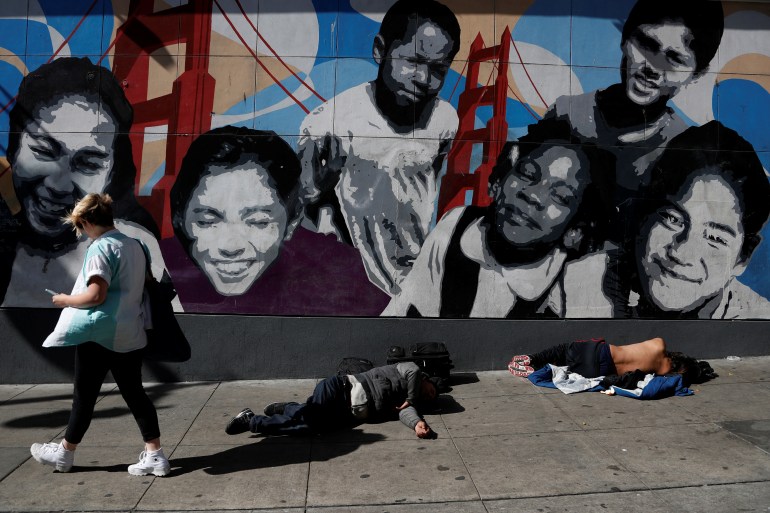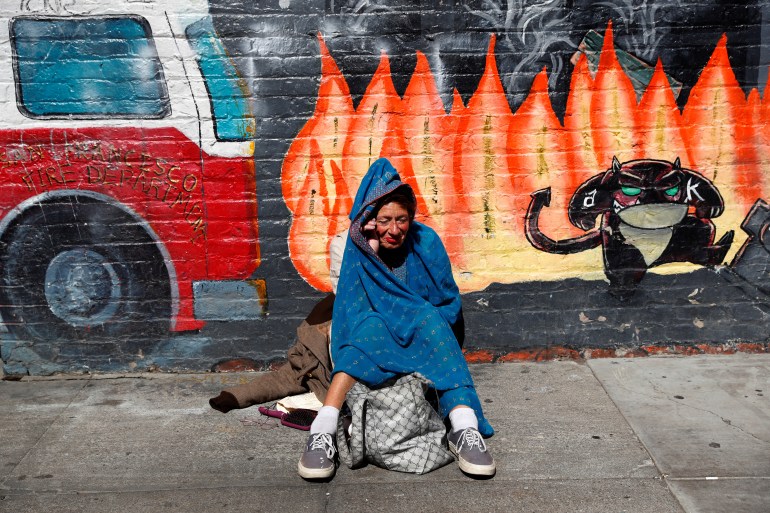With tech workers gone, what is the future of San Francisco? | Business and Economy News
A trendily dressed woman with a dog called David Ababseh out of his office at the Chai Bar cafe on San Francisco’s Market Street. Ababseh, who is the director of retail operations at the bright pink-fronted cafe that offers Indian-style tea, was in the middle of a weekly staff meeting, but the woman was persistent. She told him she had to use Chai Bar’s bathroom. Ababseh told her, as the staff had, that the bathroom was only for customers, getting her more agitated.
With Ababseh watching, she lowered her pants, squatted in the cafe and urinated while customers watched. As Ababseh escorted her out, she flicked pee on him. Tempers rose, and as the two argued on the street outside, a man came up to defend her. He pulled out a gun and threatened to kill Ababseh, who then quickly stepped back inside. He called the co-founders of Chai Bar and told them he could hardly take more of this.
Over the past few months, people had tried to set fire to the cafe, thrown bottles at its glass storefront, took its cash and threatened staff. With tech workers, the main office employees in the area, working from home since the COVID-19 pandemic began, business had dipped, and Ababseh was seeing stores closing around him.
From this month, the founders of Chai Bar decided they would only provide takeaway food and drinks. The cafe, which has been on the street since 2015, will not have seating anymore.
In the past few months, a string of stores on Market Street – including Nordstrom, Nordstrom Rack, Anthropologie, AT&T and T-Mobile – have announced closures. Westfield, which operates the San Francisco Center mall, and Park Hotels, which runs the nearby Hilton and Parc 55 hotels, said they would return the properties to lenders.
The changes on Market Street, once San Francisco’s commercial heart, are leading to questions not only about the city’s future but also about the future of work itself and the wellbeing of other business centres as employees everywhere continue to work from home, leading to high vacancy rates at office buildings.
“It was the technology revolution that really brought young people back into cities. Then the pandemic struck,” Michael Storper, a professor of economic geography at the London School of Economics, told Al Jazeera. “The challenge for cities like San Francisco is that a five-year shock should not turn into a 30-year doom cycle.”
San Francisco’s office vacancy rate is at a 22-year high because less than half of all office workers have returned to work, a rate topped only by Philadelphia and nearby Silicon Valley, according to data by the real estate consulting firm Jones Lang LeSalle.
The office vacancy rate was 26.4 percent in the third quarter of 2022, rising sharply from just 5.2 percent in the fourth quarter of 2019, the firm’s data showed. One of the tightest office markets in the country quickly came to have among the highest vacancy rates.
“Nearly 80 percent of the space in downtown San Francisco is office space, unlike New York or most other cities, which have more homes,” said Chris Roeder, executive managing director at Jones Lang LeSalle in San Francisco.
This means that since the pandemic began, downtown streets have felt very different.
Joe Eskenazi, managing editor of Mission Local, a San Francisco-based nonprofit news site, said in a CNN interview that “the difference now is that with fewer people downtown, a higher percentage you see are visibly homeless.”
Ababseh said that earlier, he had an encounter at work with an unhoused person once in two weeks but now it is twice a day.

As the city returns to post-pandemic life, crime is on the rise after a dip during the lockdowns. The San Francisco Chronicle looked at data from the Federal Bureau of Investigation and found reported crimes had gone up by 7.2 percent in 2022 from the previous year, led by thefts. While San Francisco has had a low violent crime rate, it has had a higher rate of property thefts, the numbers showed.
That’s because of “a great divergence of wealth”, Eskenazi pointed out in the CNN interview.
“The city will have to work on fixing the perception of crime, [which] has affected hotels, conventions and other things,” said Kevin Klowden, chief global strategist for the Milken Institute, an economic think tank.
The emptying of offices and shops has led to the city’s revenues falling, making it harder to fight the problem.
In March, the city announced that its budget shortfall for the year had increased to $290m, more than $90m more than its estimate just two months ago. Part of the increased deficit came from reduced property tax revenues due to the high office vacancy rates. Mayor London Breed has ordered city departments to cut 5 percent from their budgets in the next year to address this.
Coming back to work
“For two decades, academics tried to study whether interaction in person was important for work, and then the pandemic gave them a natural opportunity,” said Michael Storper, co-author of The Rise and Fall of Urban Economies, a book about how creative interaction led to the growth in the San Francisco Bay Area’s economy while the Los Angeles area’s economy faltered from its lack.
“Now San Francisco has become a test tube to understand what work needs to be done remotely and where people need to be back,” he said.

While routine jobs can be done from home, Storper said, technology companies are finding that creative work is better done in person.
At first the city’s tech companies gave up office space and let employees work from home. But Storper said the quality of work probably suffered, leading to a push for workers to come back to the office.
A University of Chicago study published in January found that worker productivity fell 8 to 19 percent as they worked from home. The study conducted on employees of the India-based global software services company HCL Technologies found that employees worked more than two hours longer from home each day to produce the same output as they did in the office. Interaction with colleagues and clients also suffered.
Kazuko Morgan, vice chairman at the San Francisco office of the real estate consulting company Cushman & Wakefield, said that after recent large-scale tech sector layoffs, workers are still finding work but employers are pushing for them to return to the office.
“We see VCs [venture capitalists] saying, ‘We want to see your office. We want to see you in full swing,’” he said.
A return to office life could also mean the return of the buzz that kept Chai Bar’s cafe going for eight years.
Bringing life back to city streets
Chai Bar was set up 27 years ago to make creative tea blends. In 2015, the founders decided to open their cafe, and the drinks soon become popular with the area’s diverse tech workforce.
But now, the street is emptier, and those who do come don’t linger in the area. Chai Bar closes at 3:30pm rather than staying open until 7:30pm as it did earlier.
Fernando Pujals, deputy director of the MidMarket Business Association, said that while people come to the area to attend the opera, ballet and theatre, they don’t stay longer.
Pujals has planned a range of arts activities in vacant spaces and collaborations with cafes to keep the area buzzing in the fall evenings. San Francisco is a city known for igniting and riding new waves, and “we are looking for the next wave,” he said.
One of those waves could be artificial intelligence. A recent report by the Brookings Institution think tank says jobs in artificial intelligence remain highly concentrated in the Bay Area. These companies are almost exclusively working in person because it allows for better interaction in the development process and they are looking for more office space to grow, Cushman & Wakefield and Jones Lang LaSalle said.
But for small businesses such as Chai Bar, the wait might be too long. If its strategy to only do takeaway doesn’t work, Ababseh said it might only make its popular tea mixes and not have a retail store at all.

Pingback: 카지노 커뮤니티 순위
Pingback: Diyala/baqubah/university/universal
Pingback: https://www.mdf-xlpages.com/modules/newbb/viewtopic.php?post_id=3514
Pingback: Mostbet
Pingback: เว็บตรง สล็อต บาคาร่า
Pingback: VOX Casino